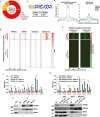ZFP281-BRCA2 prevents R-loop accumulation during DNA replication
- PMID: 35715464
- PMCID: PMC9205938
- DOI: 10.1038/s41467-022-31211-9
ZFP281-BRCA2 prevents R-loop accumulation during DNA replication
Abstract
R-loops are prevalent in mammalian genomes and involved in many fundamental cellular processes. Depletion of BRCA2 leads to aberrant R-loop accumulation, contributing to genome instability. Here, we show that ZFP281 cooperates with BRCA2 in preventing R-loop accumulation to facilitate DNA replication in embryonic stem cells. ZFP281 depletion reduces PCNA levels on chromatin and impairs DNA replication. Mechanistically, we demonstrate that ZFP281 can interact with BRCA2, and that BRCA2 is enriched at G/C-rich promoters and requires both ZFP281 and PRC2 for its proper recruitment to the bivalent chromatin at the genome-wide scale. Furthermore, depletion of ZFP281 or BRCA2 leads to accumulation of R-loops over the bivalent regions, and compromises activation of the developmental genes by retinoic acid during stem cell differentiation. In summary, our results reveal that ZFP281 recruits BRCA2 to the bivalent chromatin regions to ensure proper progression of DNA replication through preventing persistent R-loops.
© 2022. The Author(s).
Conflict of interest statement
The authors declare no competing interests.
Figures






Similar articles
-
ZFP281 Recruits MYC to Active Promoters in Regulating Transcriptional Initiation and Elongation.Mol Cell Biol. 2019 Nov 25;39(24):e00329-19. doi: 10.1128/MCB.00329-19. Print 2019 Dec 15. Mol Cell Biol. 2019. PMID: 31570506 Free PMC article.
-
DDX18 prevents R-loop-induced DNA damage and genome instability via PARP-1.Cell Rep. 2022 Jul 19;40(3):111089. doi: 10.1016/j.celrep.2022.111089. Cell Rep. 2022. PMID: 35858569
-
R Loops: From Physiological to Pathological Roles.Cell. 2019 Oct 17;179(3):604-618. doi: 10.1016/j.cell.2019.08.055. Epub 2019 Oct 10. Cell. 2019. PMID: 31607512 Review.
-
NKAP acts with HDAC3 to prevent R-loop associated genome instability.Cell Death Differ. 2023 Jul;30(7):1811-1828. doi: 10.1038/s41418-023-01182-5. Epub 2023 Jun 15. Cell Death Differ. 2023. PMID: 37322264 Free PMC article.
-
R-Loops and Its Chro-Mates: The Strange Case of Dr. Jekyll and Mr. Hyde.Int J Mol Sci. 2021 Aug 17;22(16):8850. doi: 10.3390/ijms22168850. Int J Mol Sci. 2021. PMID: 34445553 Free PMC article. Review.
Cited by
-
The role and therapeutic value of NUSAP1 in human cancers.J Transl Med. 2025 Jul 2;23(1):725. doi: 10.1186/s12967-025-06746-2. J Transl Med. 2025. PMID: 40605080 Free PMC article. Review.
-
Possible role of human ribonuclease dicer in the regulation of R loops.FEBS Open Bio. 2025 Sep;15(9):1406-1418. doi: 10.1002/2211-5463.70026. Epub 2025 Mar 24. FEBS Open Bio. 2025. PMID: 40127989 Free PMC article. Review.
-
Aberrant R-loop-mediated immune evasion, cellular communication, and metabolic reprogramming affect cancer progression: a single-cell analysis.Mol Cancer. 2024 Jan 10;23(1):11. doi: 10.1186/s12943-023-01924-6. Mol Cancer. 2024. PMID: 38200551 Free PMC article.
-
Pathophysiological Role and Diagnostic Potential of R-Loops in Cancer and Beyond.Genes (Basel). 2022 Nov 22;13(12):2181. doi: 10.3390/genes13122181. Genes (Basel). 2022. PMID: 36553448 Free PMC article. Review.
-
ZFP281 controls transcriptional and epigenetic changes promoting mouse pluripotent state transitions via DNMT3 and TET1.Dev Cell. 2024 Feb 26;59(4):465-481.e6. doi: 10.1016/j.devcel.2023.12.018. Epub 2024 Jan 17. Dev Cell. 2024. PMID: 38237590 Free PMC article.
References
Publication types
MeSH terms
Substances
LinkOut - more resources
Full Text Sources
Miscellaneous

